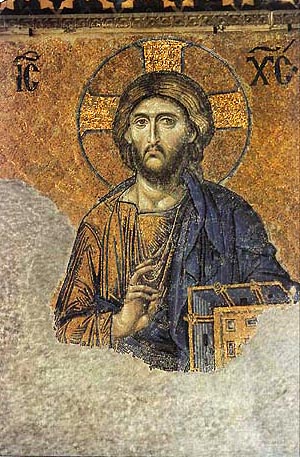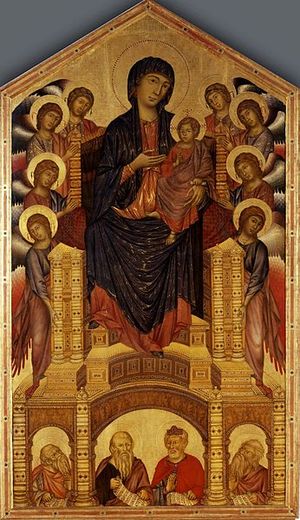Middle Ages Painting
 From Conservapedia - Reading time: 2 min
From Conservapedia - Reading time: 2 min
Middle Ages Painting is also known as the Medieval painting . After the Roman Empire collapsed, Europe's greatest inheritance was the Roman-Christian tradition, which was heavily infused with classical ideas and Christian artistic styles. During the Middle Ages the Roman Catholic Church and The Orthodox Church supported the production of sacred art. Most of this artworks, made in monasteries, were found in the form of illustrated manuscripts. During the Romanesque time from 800-1100 A.D., painting continued as illustrated manuscripts and extended to mural painting in churches. [1] Italy became the cultural center of the Western world from the 13th to the 16th century with artists like: Giovanni Cimabue (Italo-Byzantine style), Giotto di Bondone, Duccio di Buoninsegna, Fra Angelico, and Piero della Francesca. At the end of Middle Ages Hans Memling, and Hans Holbein the Elder, (ca. 1465 - 1524), created outstanding examples of Flemish and German painting.
European artists painted in a way that emphasized religious images and symbolism rather than realism. Most paintings depicted scenes holy figures and people important in the Christian religion. Even the most talented painters paid little attention to making humans and animals look lifelike, creating natural looking landscapes, or creating a sense of depth and space in their paintings. [2]
Symbolism was a huge part of the Middle Ages paintings, and that means that many of the paintings represent something that was largely valued at the time. [3]
In the Medieval painting it was the Byzantines who determined how to depict human figures... the driving concern of the Byzantine style is the awe-inspiring presentation of holy figures, and to this end they are portrayed in hieratic (stiff and formal) postures, halo-crowned and serene of expression. [4] The Byzantine Style of painting is usually characterized by a lack of background, or a very limited background. The figures are flat, lacking depth, or a sense of volume. Icons were objects of devotion, regarded as possessing divine power. [5]
See also[edit]
- The Renaissance
- Antique paintings
- History of painting
- Painting Galleries
- World famous paintings
- Christian paintings
- Russian painting

External links[edit]
- Middle Ages Painting.
- Painting Styles in the middle ages. Written by Simon Newman.
 KSF
KSF
